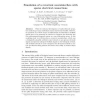Free Online Productivity Tools
i2Speak
i2Symbol
i2OCR
iTex2Img
iWeb2Print
iWeb2Shot
i2Type
iPdf2Split
iPdf2Merge
i2Bopomofo
i2Arabic
i2Style
i2Image
i2PDF
iLatex2Rtf
Sci2ools
ESANN
2008
2008
Simulation of a recurrent neurointerface with sparse electrical connections
With the technical development of multi-electrode arrays, the monitoring of many individual neurons has become feasible. However, for practical use of those arrays as bidirectional neurointerfaces, feedback signals have to be generated in real-time to integrate the electrodes into the existing spatio-temporal context as a new information source. In this modeling study we will introduce a recurrent neurointerface, which uses a biologically plausible artificial neural network to pre-process electrode signals and generate adequate feedback signals to the biological network. The artificial network is more transparent for advanced methods to analyze synchronous firing patterns and reacts more stably to external input signals.
Adequate Feedback Signals | ESANN 2008 | External Input Signals | Feedback Signals | Neural Networks |
| Added | 29 Oct 2010 |
| Updated | 29 Oct 2010 |
| Type | Conference |
| Year | 2008 |
| Where | ESANN |
| Authors | Andreas Herzog, Karsten Kube, Bernd Michaelis, Ana D. de Lima, Thomas B. Voigt |
Comments (0)

